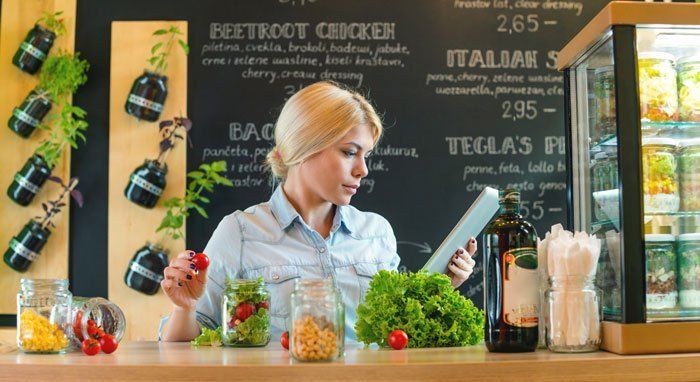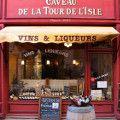To make great salads, it is all about the base (legumes, rice, quinoa, pasta) side notes, and dressing.
Corporations do everything possible to maximize profits. Often taking cost out of the product by using cheaper ingredients, and instead using this money to fund advertising convincing consumers to buy.
To make a truly great salad dressing take a closer look at these easy recipes, and remember to use only the best quality ingredients.
SALAD DRESSINGS DIY QUALITY: PART I FRENCH DRESSING
SALAD DRESSINGS DIY QUALITY: PART II THE BASICS
SALAD DRESSINGS DIY QUALITY: PART III CAESAR SALAD

Use Only the Best Ingredients
Legumes:
A successful store should stock fresh, local produce delivered daily. Fresh salad legumes are a proven traffic builder.
Add onions, garlic, shallots, and potted oregano (a must for great pesto AND a huge profit maker) to a basic blend of leaf lettuce, cabbage, romaine, red cabbage, Bok Choy, potatoes, and any other salad greens of your choice. When in season go all out.
Rice, Beans, Pasta, Quinoa
Just as important as fresh legumes, the base for any salad must include only the best ingredients. Whether rice, beans, or quinoa, a retailer should stock a variety of authentically sourced, high quality base ingredients.
Side Notes:
Side notes include all non-legume and base additions to a salad. Popular choices include flavourful cheeses, croutons, anchovies, nuts etc.
Dressing:
The musts for any salad dressing are a GREAT olive oil and a GREAT vinegar. Adding to this accents the overall taste. These additions are the “tools” to any great salad dressing, which I will share with you a little later in the post.
Great Olive Oil:
The number one mistake a retail operation makes is basing their selection of olive oils on brand, instead of on the variety of the olive.
Too broad a selection of olive oils will actually decrease a small retailer’s business in the category, often because of two very important factors: rancidity and quality.
Rancidity in an olive oil indicates it is “off”. When a customer buys an olive oil that is off, they will likely shop elsewhere in the future. Usually, without ever bringing it up to the retailer because it is not seen as the retailer’s fault. For a store with 10,000 sq. ft of space, if there are more than six olive oils on the shelf of well-known, corporate brands, the chances are good one will be off.
Quality of an olive oil is crucial. Consumers know enough to tell the difference.
To be successful, a retailer must have a small selection of single estate, current harvest, olive oil that is tree-to-bottle.
Why? Corporate brands buy olive oil on price and blend for profit. There is no longer any guarantee that you are getting the current harvest when they purchase from storage tanks holding millions of gallons of assorted, multi-nation sourced oil, identified by chemical analysis rather than region and harvest date.
I counsel against national brands of olive oil in a small retailer because:
They are generally poor quality.
The same brand will be sold at a lower price in large chain retailers.
Customers will always respect a retailer that says “I have tried a lot of olive oils and this one is the best. It offers good value without compromising quality.”
Your customers will appreciate this reasoning. I have never encountered a consumer that did not agree.
Great Vinegar:
Offer wine vinegars in a variety of flavours as long as they are all-natural with zero essences. Generally, vinegar is shelf stable so carrying an assortment is not a risk.
I also suggest carrying VERJUS, a trendy, little-known alternative with a rich history.
Organic lemons are a useful “acid-in-a-package” alternative and add zing to dressings. They are also used in the most popular of all salad recipes; Caesar Salad. As no Caesar is truly complete without them, refrigerated anchovies should also be stocked.
Red Wine vinegar should generally have 6 % acidity to avoid harshness. Sourcing vinegar locally can be risky. Few local producers take the necessary care to properly filter and pasteurize the vinegar, which eliminates vinegar worms. I suggest you take a look at a local product under a microscope. You will likely be surprised.
Apple cider vinegar is a useful ingredient as well. A retailer cannot go wrong stocking it in larger formats.
Tools of the Dressing Trade:
To truly be successful, every retailer must offer only the best “tools” for building a deliciously fresh salad. These must haves include:
Refrigerated anchovies for a great Caesar Salad.
A selection of origin specific spices and herbs.
- Black Garlic, a cutting edge ingredient from Canada.
- Dijon Mustard and Grainy Dijon in a preserve jar. They do take up valuable shelf space, but they are dressing staples and can be used on sandwiches and in marinades as well.
Every night there is a salad on my table. Please let me share yesterday’s delicious salad with you.
3 tablespoons of olive oil from Spain
1 tablespoon red wine vinegar (6% acidity)
- 1 heaping tablespoon chopped local garlic (or more if you LOVE it)
- 3 crushed cloves black garlic
- 4 tablespoons Canadian sheep’s milk feta
- 1 tablespoon oregano from the south of France
- Sprinkling of freshly crushed black pepper
- Sprinkling of sea salt
- 1 tablespoon white wine Dijon mustard (from my big preserve jar)
- 1 small fresh tomato diced fine
Mix energetically with a fork.
Taste. I added some more garlic but then again, I am a garlic fiend.
Add mixed greens (or rice, beans, quinoa, pasta etc.).
My added tool this time was finely diced COMTE cheese on top.
Using over-sized wooden salad implements, toss salad thoroughly to get the flavours of the dressing coating all of the leaves.
Extra Possible Income?
Salad is a true art. Presentation is so important.
Give this a try. Contact local woodworkers about making wooden salad bowls. This is good extra income for any retailer.
Take a look…
Best woodworking project to make an awesome wooden bowl.






